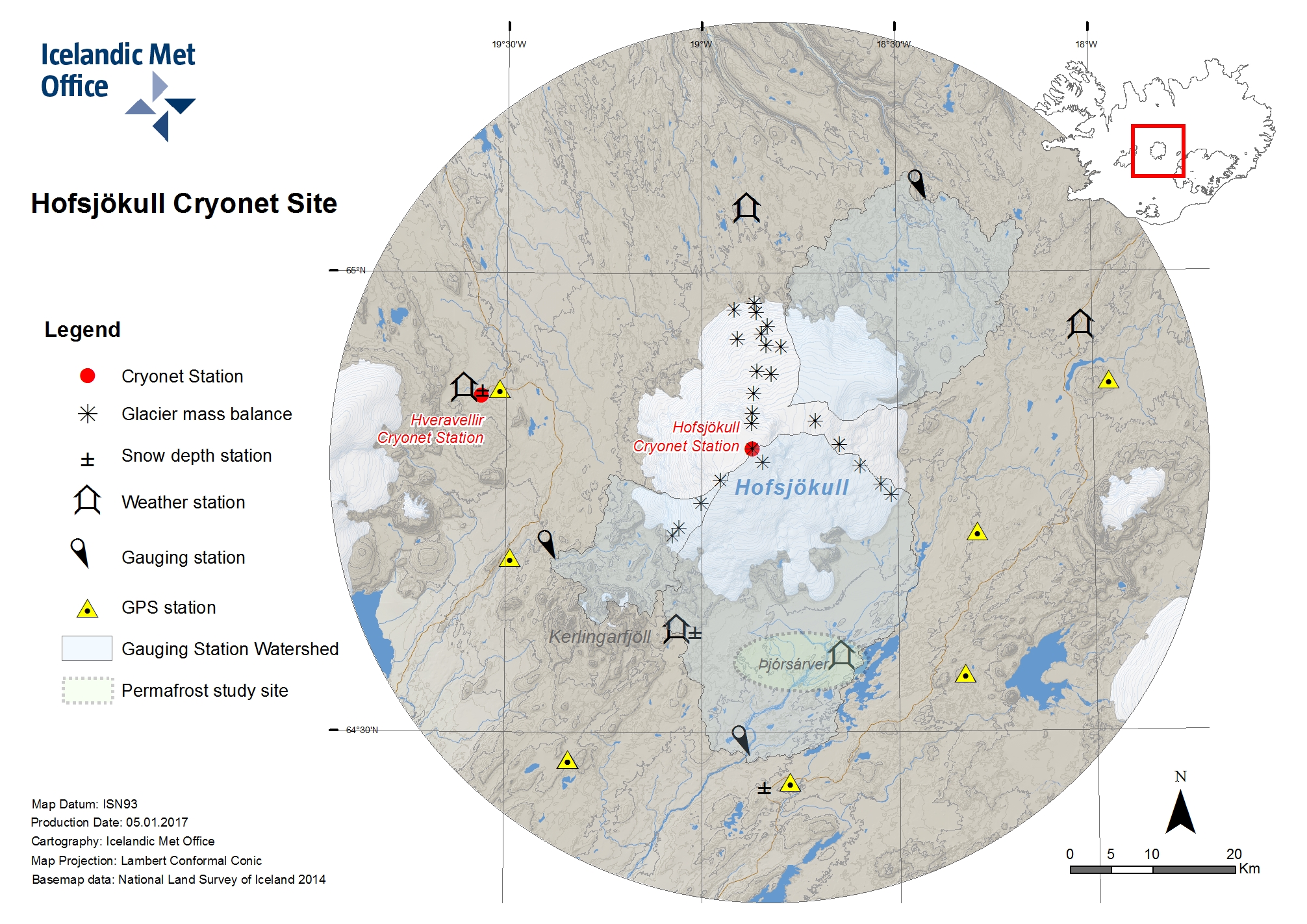Metadata
|
 |
Hofsjökull Ice Cap
Reference CryoNet Station Information
Other Networks to Which This CryoNet Station Belongs
- WGMS
- GLIMS
- Icelandic Glaciological Society: Monitoring of Glacier Variations
Measurement Methods Used
- GTN-G/WGMS
Other relevant measurement method documents:
Östrem G. and M. Brugmann, 1991, Glacier Mass Balance Measurements. A manual for field and office work. National Hydrology Research Institute (Canada), Science Report No. 4, 224 pp.
Data Information
- Are the data quality controlled? yes
- How are the data accessible? FTP, an existing data center
- Data availability (may depend on the variable measured): delayed more than one year
Publications
Einarsson, B. & Jónsson, S. (2010). The effect of climate change on runoff from two watersheds in Iceland. Icelandic Meteorological Office, Report, VÍ 2010-016. 34 pp.
Jóhannesson, T., G. Aðalgeirsdóttir, H. Björnsson, P. Crochet, E.B. Elíasson, S. Guðmundsson, J.F. Jónsdóttir, H. Ólafsson, F. Pálsson, Ó. Rögnvaldsson, O. Sigurðsson, Á. Snorrason, Ó. G. B. Sveinsson & Th. Thorsteinsson (2007). Effect of climate change on hydrology and hydro-resources in Iceland. Final Report of the project Veður og orka (Climate and Energy), OS-2007/011. 91 pp.
Jóhannesson T, Björnsson H, Magnússon E, Guðmundsson S, Pálsson F, Sigurðsson O, Thorsteinsson Th, Berthier E: Ice-volume changes, bias estimation of mass-balance measurements and changes in subglacial lakes derived by lidar-mapping of the surface of Icelandic glaciers. Annals of Glaciology 2013, 54 (63), 63-74. doi: 10.3189/2013AoG63A422
Sigurðsson, O., T. Jóhannesson, Th. Thorsteinsson & G. Larsen (2002). Ice core drilling on the Hofsjökull ice cap for measuring glacier mass balance. Nordic Hydrological Programme Report, 47. Proceedings of the XXII Nordic Hydrological Conference, Røros, Norway, August 4-7 2002.
Thorsteinsson Th, Björnsson H (Eds): Climate Change and Energy Systems. Impacts, Risks and Adaptation in the Nordic and Baltic Countries. Nordic Council of Ministers, TemaNord 2011:502, 228 pp.
Thorsteinsson, Th., T. Jóhannesson, O. Sigurðsson, E.Ö. Hreinsson, S.M. Ágústsson & E. Tómasson (2003). Afkomumælingar á hábungu Hofsjökuls í maí 2003 (Mass balance measurements at the summit of Hofsjökull, May 2003). National Energy Authority, Report OS/2003-53. 51 pp.
Measurements
The measurements made at Hofsjökull Ice Cap are listed in the following tables. (Note: If End Year is blank, measurements are ongoing.)
Cryosphere Measurements
| Atmosphere Measurements
|
Measurement Notes and Other Measurements
| Category | Description or List |
|---|---|
| Snow | Snow measurements at the Hveravellir CryoNet Station were started in 1965. Snow measurements at the Hofjökull CryoNet Station were started in 1988, forming part of the mass balance program on the ice cap. |
| Glacier | Variations of the ice cap front have been monitored regularly at the following outlet glaciers from Hofsjökull: Múlajökull: Since 1932 Nauthagajökull: Since 1932 Blágnípujökull: Since 1932 Sátujökull: Since 1950 Kvíslajökull: Since 2002 Sporadic observations exist from other outlets. |
| Hydrology | Hydrometric observations are conducted on glacial rivers flowing from Hofsjökull to S- and N-Iceland. The longest data series, on the river Þjórsá, goes back to 1948. At present 10 hydrometric stations on rivers flowing from Hofsjökull (of which 3 are included on the accompanying map) deliver real-time data on discharge, water temperature and electric conductivity. Samples for measurements of suspended sediment load are regularly collected. These hydrological measurements, showing diurnal and seasonal variations and glacier floods, provide a unique opportunity for glacier hydrology research. |
| Ecology | South of the ice cap lies the Þjórsárver natural reserve, a unique ecosystem protected by the international RAMSAR convention on wetlands and one of the few regions in Iceland where permafrost mounds have been observed and studied in detail. Detailed studies of tundra ecosystems have been carried out in Þjórsárver. In addition, communities of microbial and invertebrate life in glacial rivers of the Hofsjökull region have been investigated. |
| Oceanography | No oceanographic observations are applicable. |
| Other | Several stations for continuous, high-precision GPS-monitoring of crustal movements are operated in Iceland. It is proposed to include seven stations operated within the ranks of the CHIL (Central Highland) network in the Hofsjökull Cryonet site. These stations have been in operation since 2007 and together they yield information on isostatic adjustment in response to mass balance changes of Hofsjökull and other ice caps in the Icelandic highland. The forefield of Múlajökull, a surge-type outlet glacier from Hofsjökull, has attracted the attention of geomorphologists in recent years, as the only known presently active drumlin field on Earth. |



